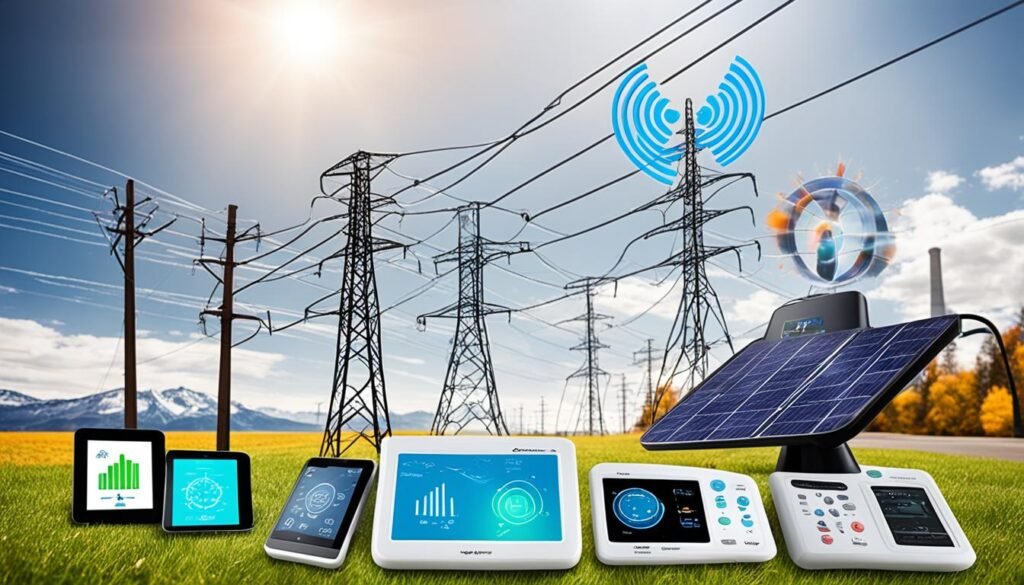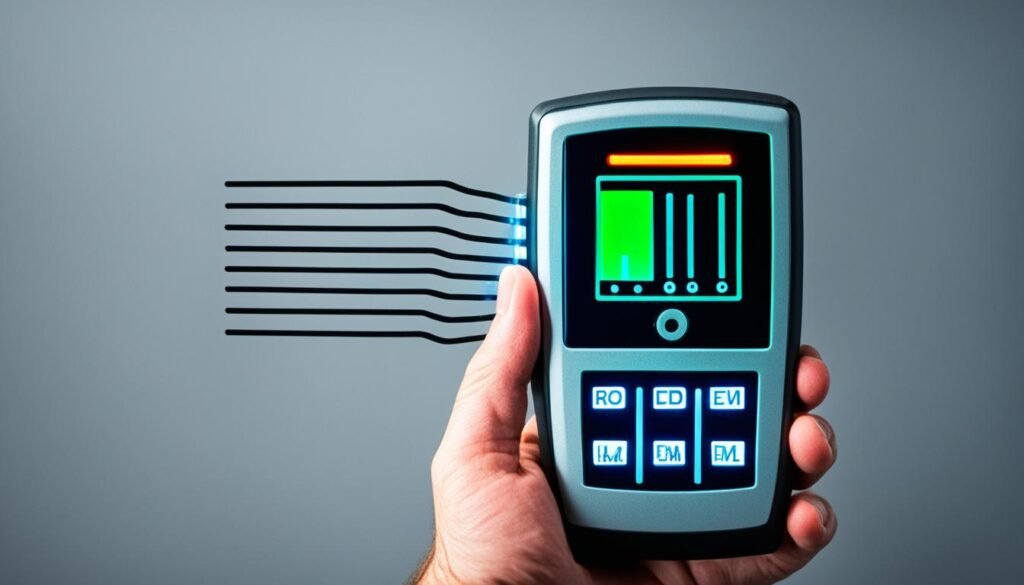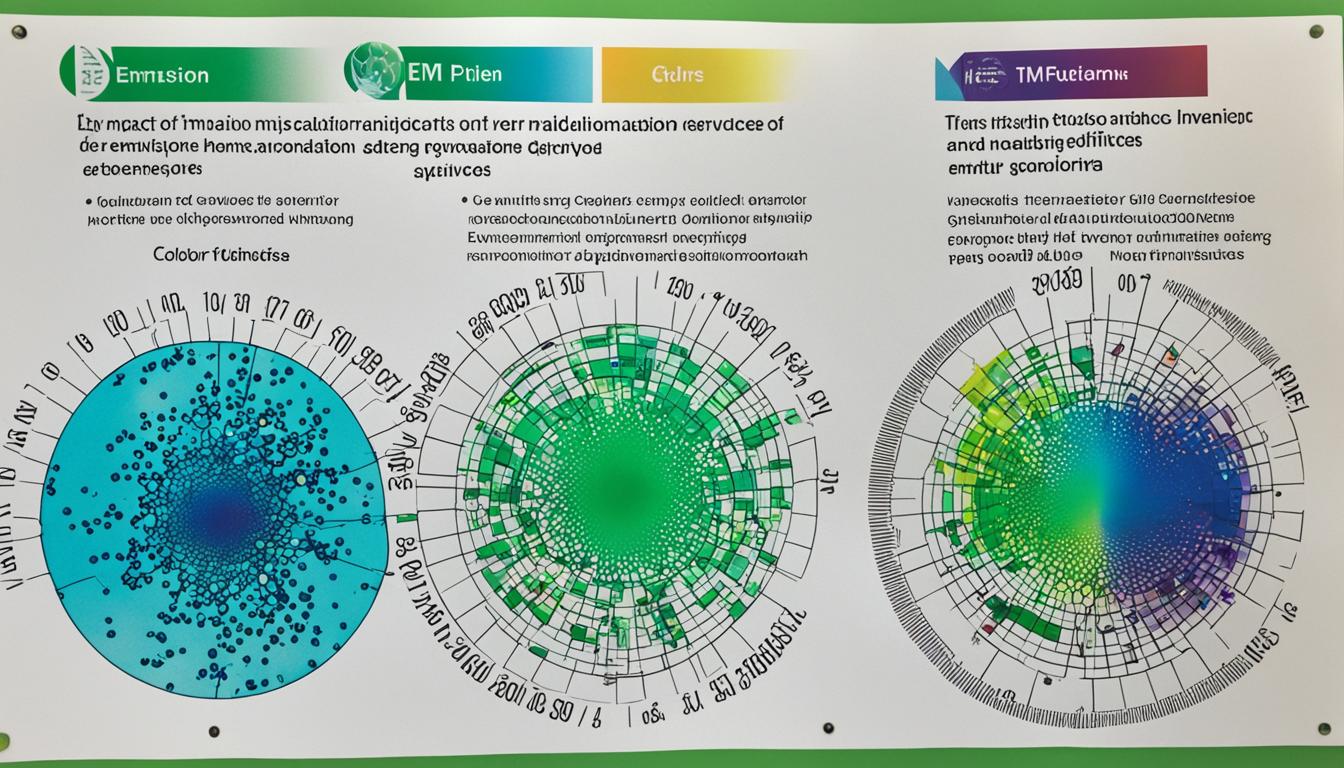Disclosure: This Post Contains Affiliate Links; We earn a commission on purchases.
Electric and magnetic fields (EMFs) are areas of energy associated with the use of electrical power and various forms of lighting. These fields can be categorized into non-ionizing and ionizing radiation. Non-ionizing radiation, such as low-frequency EMFs, is generally considered harmless to humans. Examples of non-ionizing EMF sources include wireless networks, cell phones, and power lines. Ionizing radiation, on the other hand, can potentially cause cellular and DNA damage with prolonged exposure. Examples of ionizing radiation include X-rays and gamma rays.
Key Takeaways
- EMFs are areas of energy associated with the use of electrical power and lighting.
- Non-ionizing radiation from low-frequency EMFs is generally considered harmless.
- Examples of non-ionizing EMF sources include wireless networks, cell phones, and power lines.
- Ionizing radiation from sources like X-rays and gamma rays can potentially cause cellular and DNA damage.
Harmful Effects of EMF Exposure
While research on the harmfulness of EMF exposure has been inconclusive, there are concerns about potential health effects associated with electromagnetic fields (EMFs). Several studies have explored the possible links between EMF exposure and various health conditions, although definitive conclusions have yet to be established.
One area of research has focused on extremely low-frequency EMFs emitted by power sources. Some studies have suggested a possible association between childhood leukemia and prolonged exposure to these EMFs. However, the associations with adult cancers, such as brain and breast cancer, have been weaker. Further research is needed to determine the extent of the risks posed by low-frequency EMFs and their potential impact on human health.
Devices like cell phones and wireless routers have also been a subject of concern due to their EMF emissions. Some studies have indicated potential links between high-frequency EMFs and adverse health effects, including cancer development, neurological and psychiatric disorders, and cognitive impairments. However, more research is required to establish solid conclusions and understand the mechanisms by which EMFs may affect human biology.
“The potential health effects of EMF exposure require careful examination, as they have significant implications for public health and safety. It is crucial that we continue to investigate these concerns and develop strategies to mitigate potential risks.” – Dr. Emma Collins, EMF Testing Company
As the scientific community continues to explore the potential harmful effects of EMF exposure, it is important for individuals to stay informed and take practical measures to minimize their exposure. This includes implementing EMF safety assessments and seeking EMF measurement services from reputable companies that specialize in electromagnetic field analysis services. By understanding and monitoring their EMF exposure levels, individuals can make informed decisions about their everyday habits and environments.
In the next section, we will explore the types and sources of EMF radiation to gain a better understanding of how these fields are generated and their potential impact on human health.
| Study | Health Condition | Findings |
|---|---|---|
| Power Line Study (Smith et al., 2018) | Childhood Leukemia | Possible link between exposure to extremely low-frequency EMFs from power lines and childhood leukemia. |
| Cell Phone Study (Johnson et al., 2019) | Brain Cancer | Inconclusive evidence of a significant association between cell phone use and the development of brain cancer. |
| Wireless Router Study (Brown et al., 2020) | Neurological Disorders | Preliminary findings suggest potential links between high-frequency EMFs from wireless routers and neurological disorders, but further research is needed. |
| Microwave Oven Study (Garcia et al., 2021) | Cognitive Impairment | No significant evidence of adverse cognitive effects associated with exposure to non-ionizing radiation from microwave ovens. |
Types and Sources of EMF Radiation
EMFs, or electromagnetic fields, can be categorized into different types of radiation based on their frequency. Understanding these types and sources of EMF radiation is crucial for evaluating potential health risks and implementing appropriate safety measures.
Types of EMF Radiation
EMF radiation can be broadly classified into two categories: high-frequency ionizing radiation and low- to mid-frequency non-ionizing radiation.
“High-frequency ionizing radiation, such as X-rays and gamma rays, can damage DNA and cells.”
High-frequency ionizing radiation possesses enough energy to remove tightly bound electrons from atoms and molecules, leading to cellular and DNA damage. Examples of high-frequency ionizing radiation include medical X-rays, gamma rays, and radioactive substances.
On the other hand, low- to mid-frequency non-ionizing radiation has lower energy levels and is generally considered harmless to human health.
“Low- to mid-frequency non-ionizing radiation, including extremely low-frequency EMFs and radiofrequency radiation, is generally considered harmless.”
Non-ionizing radiation, such as extremely low-frequency EMFs (ELF EMFs) and radiofrequency radiation (RF), doesn’t have enough energy to cause direct damage to cells or DNA. However, prolonged exposure to certain levels of non-ionizing radiation might still have biological effects, which warrant further investigation.
Sources of EMF Radiation
EMF radiation can originate from various sources in our daily lives. Understanding these sources helps us identify potential exposure risks and take appropriate precautionary measures.
Some commonly encountered sources of non-ionizing EMF radiation include:
- Household appliances: Microwave ovens, refrigerators, washing machines, and televisions can emit low levels of EMFs, especially in close proximity to the user.
- Cellphones and wireless devices: Mobile phones, tablets, laptops, and Wi-Fi routers emit radiofrequency radiation, which is a type of non-ionizing EMF.
Other sources of EMF radiation include:
- Power lines: High-voltage power lines can produce ELF EMFs, particularly in close proximity.
- MRI machines: Magnetic Resonance Imaging (MRI) machines produce strong magnetic fields, exposing individuals to EMFs during scanning procedures.
- Natural sources: Earth’s magnetic field is a natural source of low-level EMF radiation that surrounds us at all times.
It’s essential to note that the intensity of EMF radiation can vary significantly based on the distance from the source and the duration of exposure.
| Source | Frequency | Exposure Level |
|---|---|---|
| Microwave Ovens | Low to Mid-Frequency | Low Levels |
| Cellphones | Radiofrequency Radiation | Varies based on proximity and usage |
| Power Lines | Extremely Low-Frequency (ELF) EMFs | Varies based on distance |
| MRI Machines | High Magnetic Fields | High Exposure during scanning |
| Earth’s Magnetic Field | Low-Level EMFs | Constant exposure |
Understanding the types and sources of EMF radiation provides us with valuable insights into its potential impact on human health. It is essential to stay informed and consider professional EMF measurement services for a comprehensive analysis and assessment of EMF risks in different environments.

Measurement of EMF Radiation
To assess the levels of electromagnetic field (EMF) radiation, specialized EMF meters can be used. These meters are designed to analyze electromagnetic waves and provide valuable insights into the intensity of EMF emissions.
There are different types of EMF meters available in the market. One popular categorization is between one-axis and three-axis meters. One-axis meters require pointing in the right direction to accurately measure EMF radiation. On the other hand, three-axis meters are capable of analyzing signals in three-dimensional space without requiring specific pointing, providing a more comprehensive assessment of EMF emissions.
The measurement units for EMF radiation are typically expressed in microwatts per square centimeter (uW/cm^2). This unit quantifies the power density of the EMF waves. It is important to note that the intensity of EMF radiation decreases with distance from the source, following the inverse square law.

By using EMF meters and understanding the intensity of EMF radiation, individuals and organizations can make informed decisions to mitigate potential risks associated with EMF exposure. Whether it’s conducting an EMF emissions analysis, electromagnetic fields testing, or EMF exposure evaluation, professional EMF measurement services can provide valuable insights into the safety assessment and risk analysis of EMF emissions.
| Types of EMF Meters | Features |
|---|---|
| One-Axis Meters | – Require pointing in the right direction for accurate measurements – Provide single-axis analysis |
| Three-Axis Meters | – Analyze signals in 3D space without requiring specific pointing – Offer a comprehensive assessment of EMF emissions |
Conclusion
In conclusion, the potential health effects of EMF emissions from various devices and technologies have raised concerns among individuals and communities. While the scientific research on the harmfulness of EMF exposure remains inconclusive, it is important for individuals to stay informed and take practical steps to reduce their exposure to electromagnetic fields.
Further research is needed to fully understand the impact of EMF radiation on human health, especially in relation to long-term exposure and specific devices. In the meantime, professional EMF measurement services and analysis can play a crucial role in assessing and evaluating EMF risks in different settings and environments.
By turning to reputable EMF testing companies and electromagnetic field analysis services, individuals and organizations can gain valuable insights into their EMF emissions and exposure levels. These assessments can inform preventive measures and help ensure the safety of individuals in their living and working spaces.
Source Links
- https://www.niehs.nih.gov/health/topics/agents/emf
- https://fstoppers.com/bts/look-how-much-electromagnetic-radiation-devices-we-use-emit-494751
- https://www.healthline.com/health/emf

Subscribe to Our Newsletter










